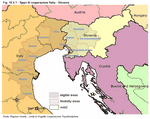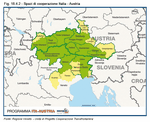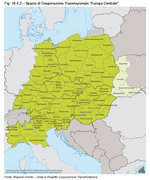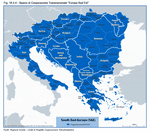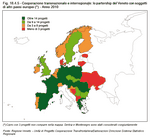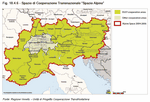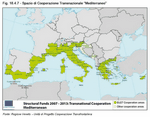(Note 1) Today the European Union is made up of 27 Member States that encompass a community and a single market of 493 million people. However, there are major economic and social disparities among these States and their 271 regions. With its current policy of providing regions with structural funds, the EU aims to produce tangible results that use territorial cohesion to correct the main imbalances within the EU, to reduce gaps in economic and social development among European regions and to support and enhance potential.
There are three objectives in Europe's Regional Policy for 2007-2013 (Convergence, Competitiveness and Cooperation) and they aim to create a potential that will enable sustainable development to take place in regions and to promote an exchange of ideas and good practices that are in line with EU priorities for growth and employment (Lisbon Strategies).
The whole of the EU is dealing with at least one of these three Objectives, but it is the European Territorial Cooperation objective (ex-Interreg) with its 8.7 billion euro worth of funds-2.5% of the total structural funds-that spans and connects the EU. The objective and the resources are divided into three sections ranging from major to minor cooperation
intensity: 6.44 billion euro for Cross-Border Cooperation; 1.83 billion euro for Transnational Cooperation; and 445 billion euro for Interregional Cooperation
(Note 2).
There are 181.7 million people living in cross-border areas (37.5% of the EU's entire population), while all the EU's regions and citizens come under one of the thirteen Transnational Cooperation environments, and Interregional Cooperation also covers the entire EU territory.
This new Objective is based on the experience of the previous Community initiative INTERREG and it confirms the EU's
mission to strengthen Cross-Border Cooperation with shared initiatives at both local and regional level, to support Transnational Cooperation for integrated territorial development across vast areas, as well as to promote cooperation and swapping of experiences at interregional level. What distinguishes and characterises this Objective is the cooperation between territories: sharing a problem and seeking a solution together
by creating a network is the basis of each project; the networks are larger or smaller in accordance with the extent of the eligible spaces within the Programmes or the distance of the partners from borders.
The common theme of all of these projects, be they cross-border or transnational, is their need to involve subjects from different regions and European States, whether they border one another or not, or whether they are inside or outside the EU. The networks created by the project partnerships are the instrument through which economic and social cohesion is strengthened from grassroots level, i.e. they require different territories, communities and national organisations to liaise and cooperate. The purpose is to avoid national borders being an economic, cultural and social barrier that might hinder balanced development and cohesion within European territory, thus facilitating the integration of candidate and neighbouring countries in order to speed up "l'acquis communitaire" and the sense of belonging.
The network is an intangible infrastructure and the cooperation projects very rarely involve physical investments, unless pilot actions run in accordance with project strategies are being introduced. The network may encompass a wide range of issues; projects converge upon matters such as economic development, spatial planning, safeguarding of cultural and natural patrimony, creation of networks of economic, social and healthcare services, mobility, transport and logistics, information society, research cooperation and technology sharing.
Interreg IVC is a programme that
by definition creates networks between institutions, the world of research and civil society; Interregional Cooperation is what breathes life into the most extensive networks by establishing partnerships that unite the whole of Europe rather than stopping them at the borders set by operational programmes.
This programme has created the most amount of partnerships, but in a wider vision, we can appreciate how over the years these cooperation programmes have been a workshop for Veneto, whereby a range of subjects have experimented with ideas and solutions to deal with problems that are shared by other areas of European territory.
The partners in the various programmes have drawn up solutions and strategies geared towards the development of their territories, both border areas as well as those further afield, thus confirming the objective to break down the economic, cultural and administrative barriers that are created by borders.
Over the last two periods of programming for the EU's structural funds, public and private bodies and organisations in Veneto have played a major role in the processes of creating networks with players from other European countries.
European Territorial Cooperation has made
setting up networks its founding philosophy. The added value of European Territorial Cooperation projects is the setting up networks of competences, experience, as well as human and economic resources, to deal with shared issues or problems that it would make no sense to have managed by one area. The aim is to enable different countries to share solutions and results by analysing shared issues. The projects cover the requirements and problems concerning the development of a vast area: i.e. issues that can be dealt with more successfully and efficiently together.
In the previous period of programming (2000-2006), we notice that the majority of partnerships that involved organisations in Veneto were undertaken within Cross-Border Cooperation
(Table 18.4.1).
This cooperation aims to bridge the development
gaps of border areas, which are often far from administrative and political centres, making them peripheral and sometimes less favoured. Veneto borders Austria to the north and Slovenia across the Adriatic Sea; Veneto's public and private bodies and organisations have woven a number of partnerships with these two countries, as shown by the vast range of projects funded by the Italy-Austria and Italy-Slovenia programmes
(Figure 18.4.1) and
(Figure 18.4.2).
There is a more active relationship with these countries, and cooperation projects are geared towards bridging the development divide caused by historical events, in particular in Eastern European countries and the Balkans. Within Cross-Border and Interregional Cooperation, Veneto has set up a number of partnerships in the Central, Adriatic, Danubian and South-Eastern European Space programme (CADSES); it has also set up partnerships in the Adriatic Cross-Border programme, which although is a cross-border programme, it involves six countries-including five non-EU ones-so it works along the same lines as a transnational programme.
A brief glance at the performance of Veneto shows that it has been involved in 285 financed projects within the various interregional programmes, which involved setting up 427 partnerships.
These shared actions were geared towards strengthening dialogue and mutual understanding between partner countries, thus contributing to an increase in the responsibility of institutions and private partners as regards matters that concern the whole of Europe.
The current programming period, which will end in 2013, sees this trend continue, although figures are not yet available on all of the programmes; initial proposals for some projects, e.g. with Slovenia and the Balkans, still need to be assessed.
Relations with Austria continue to be important, also in transnational programmes; within this environment, the initial proposals confirmed and widened the cooperation networks founded by CADSES, which has since been broken down into two new cooperation areas: Central Europe and South-East Europe
(Figure 18.4.3),
(Figure 18.4.4) and
(Table 18.4.2).
The map that summarises the number of partnerships that involve Veneto with other European organisations in Transnational and Cross-Border Cooperation highlights the intensity of relations with Slovenia. Veneto and Slovenia are involved in the same programmes, which is mostly certainly due to their proximity and their lively economies; both are always on the lookout for new funds that will support the work of their institutions and businesses
(Figure 18.4.5).
After Slovenia come Germany and Austria, countries with which Veneto shares history and issues regarding Alpine areas
(Figure 18.4.6).
The structural and economic
gaps of mountain areas and their impoverishment across Europe, with the consequent improvement of the plains, made it natural to develop a major number of Transnational Cooperation partnerships, as well as the above-mentioned Italy-Austria cross-border programme.
The figure for Poland is also similar, and Poland's organisations are amongst the most active in their attempts to bridge the gap imposed by history; Veneto's partnerships with Poland are increasing and they stretch across Germany and Austria. There are also some interesting figures for cooperation with Greece and Spain, two Mediterranean areas in which Veneto is participating for the first time, showing that it is able to build new networks
(Figure 18.4.7).






